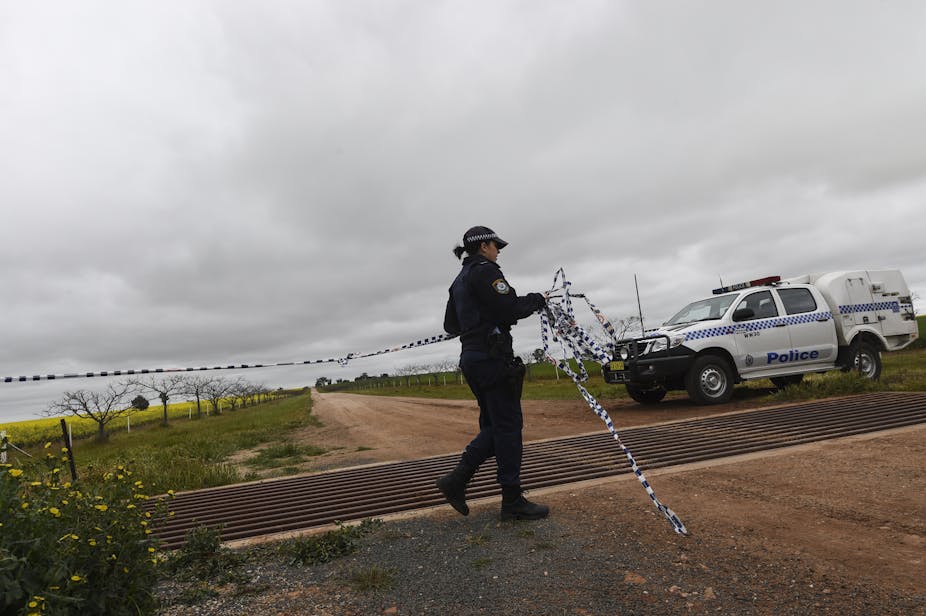Last week’s tragic deaths of the Hunt family, in what police are treating as a multiple homicide-suicide incident, have left a close-knit community in shock. It is always hard to understand why such events happen, especially as police report there were no “typical” risk factors for violence.
The case is now subject to ongoing investigations, so it’s unhelpful to speculate about “ifs” and “maybes”. But confronting events of this nature inevitably raise public interest in homicide-suicide and how we can prevent it.
How common is homicide-suicide?
Homicide-suicide is a rare event. Of the 611 Australian homicide offenders identified in 2008–09 and 2009–10, only 20 offenders (around 3%) died by suicide at the time of, or shortly after, the homicide incident.
The occurrence of homicide-suicide appears to have been relatively stable over time, although the small number of events each year can make this difficult to assess. The rarity of homicide-suicide also makes it hard to study.
Australia’s yearly homicide-suicide rate, which takes population size into account, equates to fewer than one death per million people, on average. This is comparable with other Commonwealth countries such as New Zealand, England and Wales, and Canada.
What risk factors should we look out for?
Homicide-suicide events have some common demographic characteristics. The perpetrators are usually men. They are often, but not always, older men who usually kill a current or former intimate partner (and sometimes their children).
In contrast, when women perpetrate homicide-suicide, children are almost always the only victims.
Less is known about the pathways leading to homicide-suicide events. Possible warning signs such as domestic violence and family breakdown are often highlighted. A number of high-profile homicide-suicides in Australia have occurred in the context of domestic violence and relationship conflict.
But issues relating to domestic violence and/or family breakdown are not unique to homicide-suicide events. Research shows those factors are associated with homicides and suicides too.
A recent review of multiple international studies suggests that past domestic violence appears to be less common among homicide-suicide cases, relative to homicide incidents where perpetrators do not take their own lives. This tells us to avoid the temptation of viewing all homicide-suicide events between intimate partners through a domestic violence lens.
Adding further complexity, most domestic violence incidents do not end in homicide-suicide. So, what sets that small percentage of perpetrators on a deadly pathway?
Other potential risk factors for homicide-suicide include legal problems, job problems, financial problems, other social stressors and interpersonal problems, psychiatric illness, feelings of personal failure and/or shame, as well as alcohol and substance use.
But many people experience those circumstances and stressors without perpetrating lethal violence. And, just like domestic violence, these risk factors have been associated with intentional deaths more generally. They may not tell us anything unique about homicide-suicide.
Where is research taking us?
To better understand homicide-suicide in Australia, we need to know more about specific circumstances and stressors that could set homicide-suicide apart from other types of intentional death. We have started comparing homicide-suicide perpetrators with homicide perpetrators who did not take their own lives, and people who died by suicide but did not kill others.
Homicide-suicide perpetrators appear to share many characteristics with the suicide-only group. This includes levels of contact with mental health professionals in the three months prior to death. Around three in ten homicide-suicide perpetrators had such contact. Among the suicide-only group, this rises to over four in ten people. In the homicide-only group it was around one in ten.

The homicide-suicide and suicide-only groups often look quite different to the homicide-only group. For example, the homicide-suicide and suicide-only groups were less likely to have experienced relationship separation, or to misuse alcohol and/or illicit drugs, relative to the homicide-only group.
On other factors, such as financial problems, the homicide-suicide group look similar to both the homicide-only and suicide-only groups.
It seems very few risk factors are unique to homicide-suicide. But this group were more likely to have a domestic (or apprehended) violence order in place against them, than either of the other two groups.
Can we prevent homicide-suicide?
Predicting lethal violence is challenging at the best of times. The complexity and rarity of homicide-suicide makes it almost impossible to anticipate. Although prediction may not be possible, this should not discourage us from developing responses tailored towards high-risk groups and situations.
Because homicide-suicide can have a lot in common with both homicide-only and suicide-only, one way to tackle homicide-suicide may be through carefully targeted, evidence-based suicide prevention and homicide prevention strategies.
There are potential intervention points where improvements can be made. Gatekeeper training of medical practitioners, for instance, is increasingly recognised as useful in suicide prevention. It may be valuable for such training to include education about the possibility of violence towards others, as well as to the self.
Also, practitioners in the policing and justice systems – especially those working in the context of domestic violence order enforcement – may benefit from improved knowledge about violence towards the self, as well as towards others.
Clearly, policies considering homicide-suicide need to be built on a fundamentally collaborative basis. They must bring together knowledge held by a range of health, justice, and other skilled professionals.
It is equally clear that, until we better understand the pathways to lethal violence, homicide-suicide will remain one of the most complex forms of violence to address.
The National Sexual Assault, Family and Domestic Violence Counselling Line – 1800 RESPECT (1800 737 732) – is available 24 hours a day, seven days a week for any Australian who has experienced, or is at risk of, family and domestic violence and/or sexual assault.
Anyone seeking support and information about suicide can contact Lifeline on 131 114 or beyondblue 1300 22 46 36.

